Comparative Analysis: Constitutional Validity of Child Sex Abuse Acts
VerifiedAdded on 2019/09/23
|8
|2324
|415
Report
AI Summary
This report provides a comprehensive analysis of the constitutional validity of the Child Sex Abuse (Justice for Survivors) Act 2016 and the Consequences for Cover Ups Act 2016 (NSW). It begins by outlining the background of the Royal Commission and the Commonwealth Government's response to institutional cover-ups of child sex abuse, highlighting the significant economic and psychological impact on victims and the Australian economy. The report then delves into the constitutional validity of each act, discussing key provisions, potential discrepancies, and the importance of safeguarding child witnesses. It examines the retrospective removal of civil time limits, the creation of legal frameworks to address unfair settlements, and the re-establishment of civil jury trials. The analysis also considers the roles of the Prime Minister and other key figures, as well as the need for procedural fairness and accountability. The report concludes by assessing the overall constitutional validity of both acts, noting any caveats and emphasizing the importance of protecting victims and ensuring justice within the legal framework. The report references key sources such as the Australian Institute of Criminology and The Journal of Pediatrics.
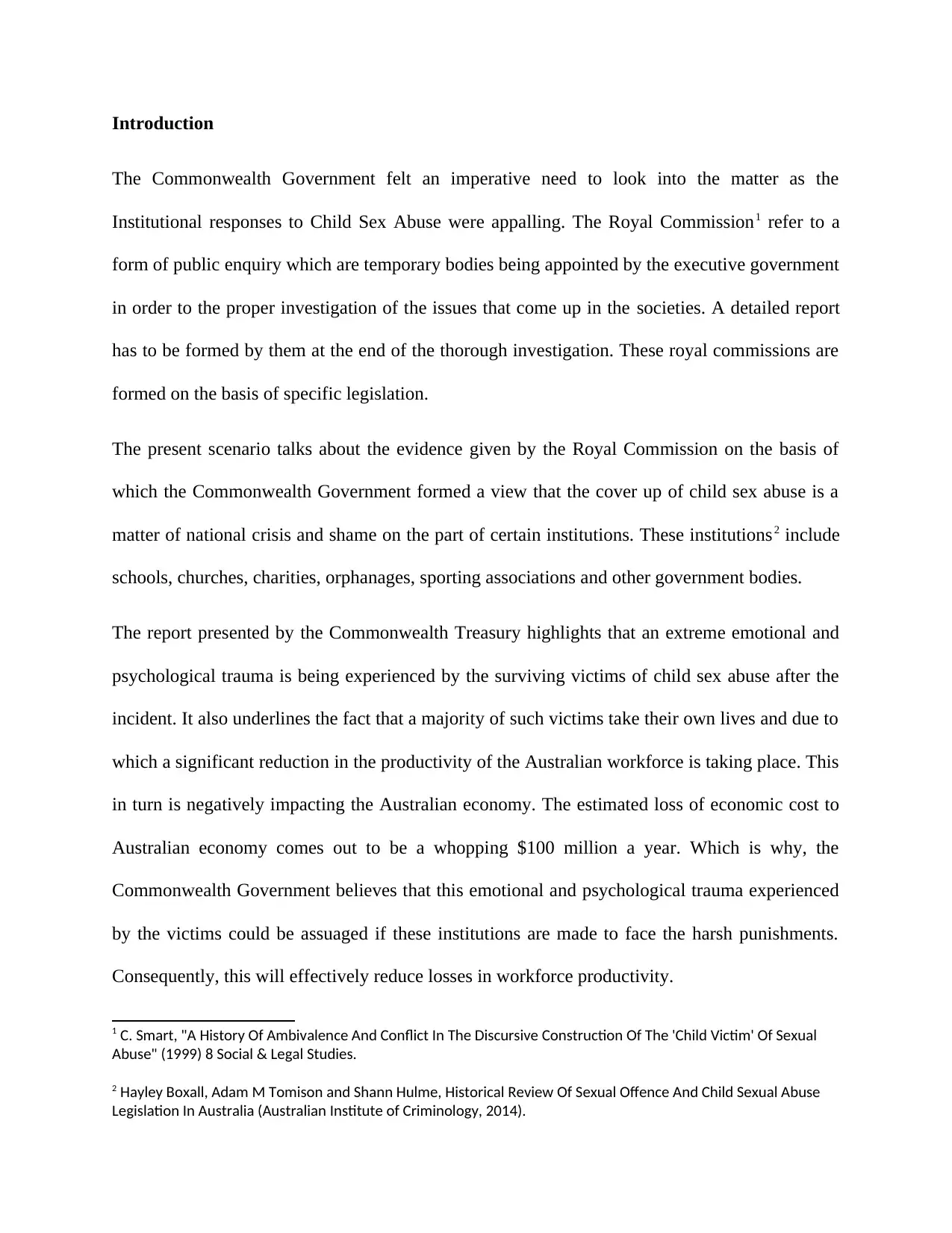
Introduction
The Commonwealth Government felt an imperative need to look into the matter as the
Institutional responses to Child Sex Abuse were appalling. The Royal Commission1 refer to a
form of public enquiry which are temporary bodies being appointed by the executive government
in order to the proper investigation of the issues that come up in the societies. A detailed report
has to be formed by them at the end of the thorough investigation. These royal commissions are
formed on the basis of specific legislation.
The present scenario talks about the evidence given by the Royal Commission on the basis of
which the Commonwealth Government formed a view that the cover up of child sex abuse is a
matter of national crisis and shame on the part of certain institutions. These institutions2 include
schools, churches, charities, orphanages, sporting associations and other government bodies.
The report presented by the Commonwealth Treasury highlights that an extreme emotional and
psychological trauma is being experienced by the surviving victims of child sex abuse after the
incident. It also underlines the fact that a majority of such victims take their own lives and due to
which a significant reduction in the productivity of the Australian workforce is taking place. This
in turn is negatively impacting the Australian economy. The estimated loss of economic cost to
Australian economy comes out to be a whopping $100 million a year. Which is why, the
Commonwealth Government believes that this emotional and psychological trauma experienced
by the victims could be assuaged if these institutions are made to face the harsh punishments.
Consequently, this will effectively reduce losses in workforce productivity.
1 C. Smart, "A History Of Ambivalence And Conflict In The Discursive Construction Of The 'Child Victim' Of Sexual
Abuse" (1999) 8 Social & Legal Studies.
2 Hayley Boxall, Adam M Tomison and Shann Hulme, Historical Review Of Sexual Offence And Child Sexual Abuse
Legislation In Australia (Australian Institute of Criminology, 2014).
The Commonwealth Government felt an imperative need to look into the matter as the
Institutional responses to Child Sex Abuse were appalling. The Royal Commission1 refer to a
form of public enquiry which are temporary bodies being appointed by the executive government
in order to the proper investigation of the issues that come up in the societies. A detailed report
has to be formed by them at the end of the thorough investigation. These royal commissions are
formed on the basis of specific legislation.
The present scenario talks about the evidence given by the Royal Commission on the basis of
which the Commonwealth Government formed a view that the cover up of child sex abuse is a
matter of national crisis and shame on the part of certain institutions. These institutions2 include
schools, churches, charities, orphanages, sporting associations and other government bodies.
The report presented by the Commonwealth Treasury highlights that an extreme emotional and
psychological trauma is being experienced by the surviving victims of child sex abuse after the
incident. It also underlines the fact that a majority of such victims take their own lives and due to
which a significant reduction in the productivity of the Australian workforce is taking place. This
in turn is negatively impacting the Australian economy. The estimated loss of economic cost to
Australian economy comes out to be a whopping $100 million a year. Which is why, the
Commonwealth Government believes that this emotional and psychological trauma experienced
by the victims could be assuaged if these institutions are made to face the harsh punishments.
Consequently, this will effectively reduce losses in workforce productivity.
1 C. Smart, "A History Of Ambivalence And Conflict In The Discursive Construction Of The 'Child Victim' Of Sexual
Abuse" (1999) 8 Social & Legal Studies.
2 Hayley Boxall, Adam M Tomison and Shann Hulme, Historical Review Of Sexual Offence And Child Sexual Abuse
Legislation In Australia (Australian Institute of Criminology, 2014).
Secure Best Marks with AI Grader
Need help grading? Try our AI Grader for instant feedback on your assignments.
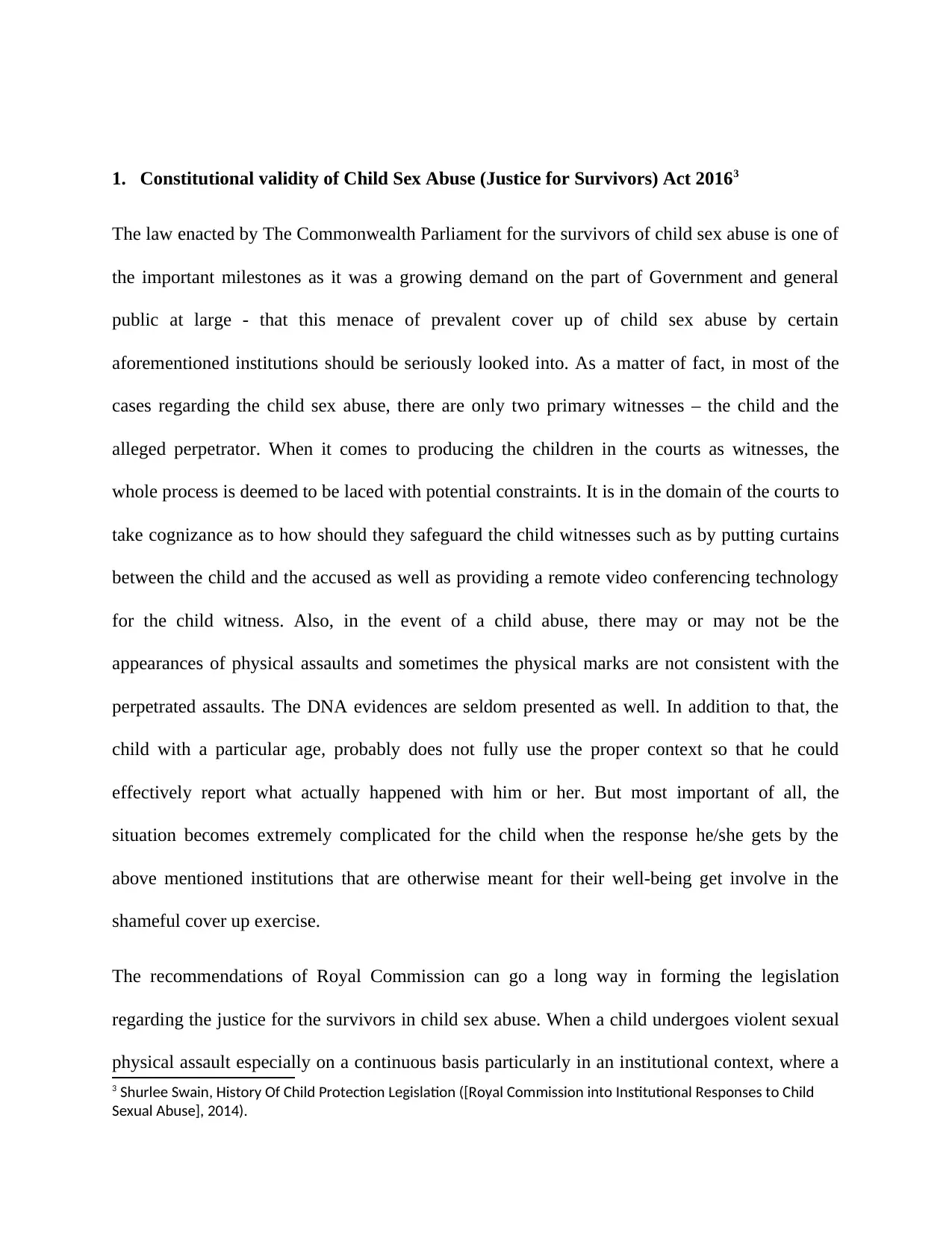
1. Constitutional validity of Child Sex Abuse (Justice for Survivors) Act 20163
The law enacted by The Commonwealth Parliament for the survivors of child sex abuse is one of
the important milestones as it was a growing demand on the part of Government and general
public at large - that this menace of prevalent cover up of child sex abuse by certain
aforementioned institutions should be seriously looked into. As a matter of fact, in most of the
cases regarding the child sex abuse, there are only two primary witnesses – the child and the
alleged perpetrator. When it comes to producing the children in the courts as witnesses, the
whole process is deemed to be laced with potential constraints. It is in the domain of the courts to
take cognizance as to how should they safeguard the child witnesses such as by putting curtains
between the child and the accused as well as providing a remote video conferencing technology
for the child witness. Also, in the event of a child abuse, there may or may not be the
appearances of physical assaults and sometimes the physical marks are not consistent with the
perpetrated assaults. The DNA evidences are seldom presented as well. In addition to that, the
child with a particular age, probably does not fully use the proper context so that he could
effectively report what actually happened with him or her. But most important of all, the
situation becomes extremely complicated for the child when the response he/she gets by the
above mentioned institutions that are otherwise meant for their well-being get involve in the
shameful cover up exercise.
The recommendations of Royal Commission can go a long way in forming the legislation
regarding the justice for the survivors in child sex abuse. When a child undergoes violent sexual
physical assault especially on a continuous basis particularly in an institutional context, where a
3 Shurlee Swain, History Of Child Protection Legislation ([Royal Commission into Institutional Responses to Child
Sexual Abuse], 2014).
The law enacted by The Commonwealth Parliament for the survivors of child sex abuse is one of
the important milestones as it was a growing demand on the part of Government and general
public at large - that this menace of prevalent cover up of child sex abuse by certain
aforementioned institutions should be seriously looked into. As a matter of fact, in most of the
cases regarding the child sex abuse, there are only two primary witnesses – the child and the
alleged perpetrator. When it comes to producing the children in the courts as witnesses, the
whole process is deemed to be laced with potential constraints. It is in the domain of the courts to
take cognizance as to how should they safeguard the child witnesses such as by putting curtains
between the child and the accused as well as providing a remote video conferencing technology
for the child witness. Also, in the event of a child abuse, there may or may not be the
appearances of physical assaults and sometimes the physical marks are not consistent with the
perpetrated assaults. The DNA evidences are seldom presented as well. In addition to that, the
child with a particular age, probably does not fully use the proper context so that he could
effectively report what actually happened with him or her. But most important of all, the
situation becomes extremely complicated for the child when the response he/she gets by the
above mentioned institutions that are otherwise meant for their well-being get involve in the
shameful cover up exercise.
The recommendations of Royal Commission can go a long way in forming the legislation
regarding the justice for the survivors in child sex abuse. When a child undergoes violent sexual
physical assault especially on a continuous basis particularly in an institutional context, where a
3 Shurlee Swain, History Of Child Protection Legislation ([Royal Commission into Institutional Responses to Child
Sexual Abuse], 2014).
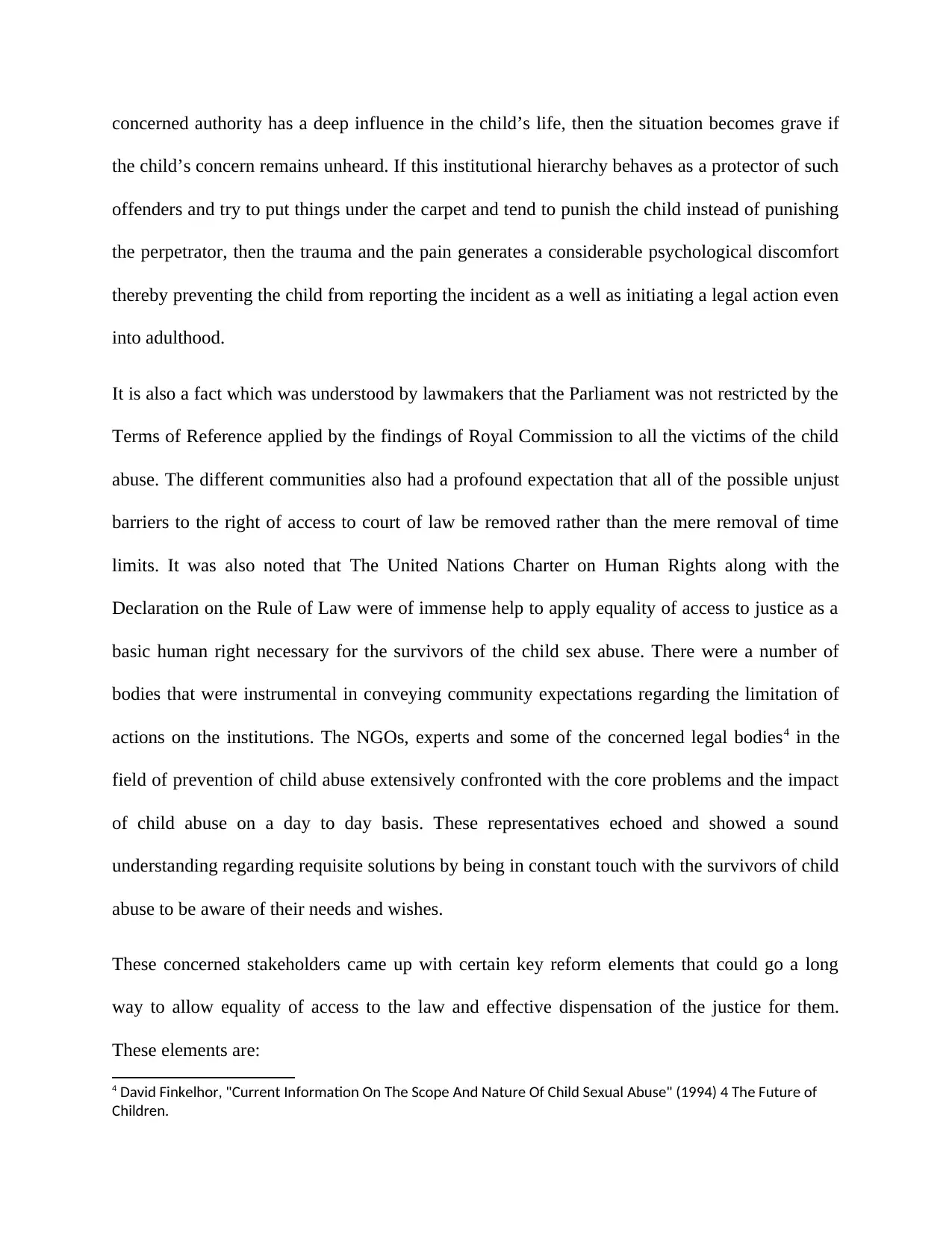
concerned authority has a deep influence in the child’s life, then the situation becomes grave if
the child’s concern remains unheard. If this institutional hierarchy behaves as a protector of such
offenders and try to put things under the carpet and tend to punish the child instead of punishing
the perpetrator, then the trauma and the pain generates a considerable psychological discomfort
thereby preventing the child from reporting the incident as a well as initiating a legal action even
into adulthood.
It is also a fact which was understood by lawmakers that the Parliament was not restricted by the
Terms of Reference applied by the findings of Royal Commission to all the victims of the child
abuse. The different communities also had a profound expectation that all of the possible unjust
barriers to the right of access to court of law be removed rather than the mere removal of time
limits. It was also noted that The United Nations Charter on Human Rights along with the
Declaration on the Rule of Law were of immense help to apply equality of access to justice as a
basic human right necessary for the survivors of the child sex abuse. There were a number of
bodies that were instrumental in conveying community expectations regarding the limitation of
actions on the institutions. The NGOs, experts and some of the concerned legal bodies4 in the
field of prevention of child abuse extensively confronted with the core problems and the impact
of child abuse on a day to day basis. These representatives echoed and showed a sound
understanding regarding requisite solutions by being in constant touch with the survivors of child
abuse to be aware of their needs and wishes.
These concerned stakeholders came up with certain key reform elements that could go a long
way to allow equality of access to the law and effective dispensation of the justice for them.
These elements are:
4 David Finkelhor, "Current Information On The Scope And Nature Of Child Sexual Abuse" (1994) 4 The Future of
Children.
the child’s concern remains unheard. If this institutional hierarchy behaves as a protector of such
offenders and try to put things under the carpet and tend to punish the child instead of punishing
the perpetrator, then the trauma and the pain generates a considerable psychological discomfort
thereby preventing the child from reporting the incident as a well as initiating a legal action even
into adulthood.
It is also a fact which was understood by lawmakers that the Parliament was not restricted by the
Terms of Reference applied by the findings of Royal Commission to all the victims of the child
abuse. The different communities also had a profound expectation that all of the possible unjust
barriers to the right of access to court of law be removed rather than the mere removal of time
limits. It was also noted that The United Nations Charter on Human Rights along with the
Declaration on the Rule of Law were of immense help to apply equality of access to justice as a
basic human right necessary for the survivors of the child sex abuse. There were a number of
bodies that were instrumental in conveying community expectations regarding the limitation of
actions on the institutions. The NGOs, experts and some of the concerned legal bodies4 in the
field of prevention of child abuse extensively confronted with the core problems and the impact
of child abuse on a day to day basis. These representatives echoed and showed a sound
understanding regarding requisite solutions by being in constant touch with the survivors of child
abuse to be aware of their needs and wishes.
These concerned stakeholders came up with certain key reform elements that could go a long
way to allow equality of access to the law and effective dispensation of the justice for them.
These elements are:
4 David Finkelhor, "Current Information On The Scope And Nature Of Child Sexual Abuse" (1994) 4 The Future of
Children.
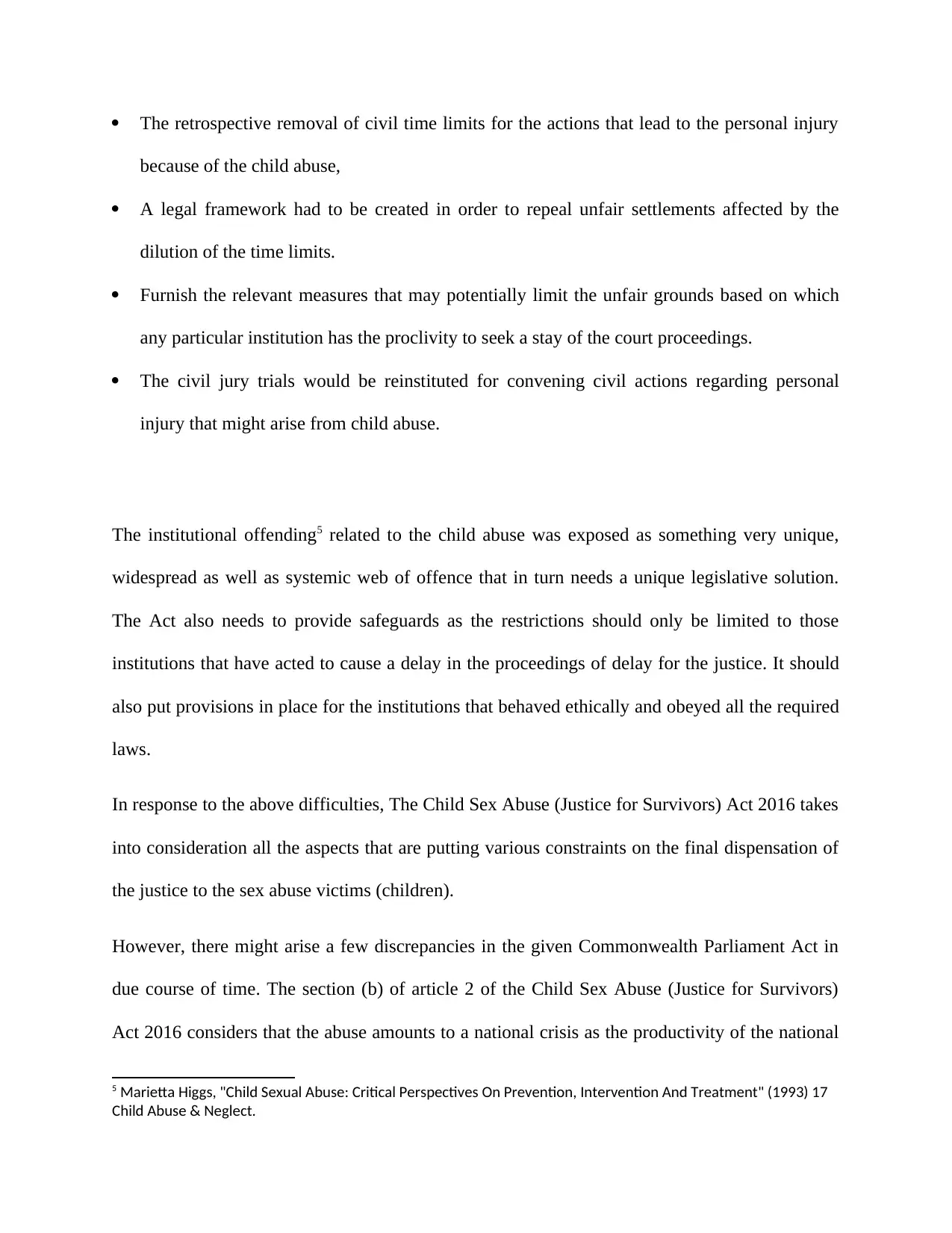
The retrospective removal of civil time limits for the actions that lead to the personal injury
because of the child abuse,
A legal framework had to be created in order to repeal unfair settlements affected by the
dilution of the time limits.
Furnish the relevant measures that may potentially limit the unfair grounds based on which
any particular institution has the proclivity to seek a stay of the court proceedings.
The civil jury trials would be reinstituted for convening civil actions regarding personal
injury that might arise from child abuse.
The institutional offending5 related to the child abuse was exposed as something very unique,
widespread as well as systemic web of offence that in turn needs a unique legislative solution.
The Act also needs to provide safeguards as the restrictions should only be limited to those
institutions that have acted to cause a delay in the proceedings of delay for the justice. It should
also put provisions in place for the institutions that behaved ethically and obeyed all the required
laws.
In response to the above difficulties, The Child Sex Abuse (Justice for Survivors) Act 2016 takes
into consideration all the aspects that are putting various constraints on the final dispensation of
the justice to the sex abuse victims (children).
However, there might arise a few discrepancies in the given Commonwealth Parliament Act in
due course of time. The section (b) of article 2 of the Child Sex Abuse (Justice for Survivors)
Act 2016 considers that the abuse amounts to a national crisis as the productivity of the national
5 Marietta Higgs, "Child Sexual Abuse: Critical Perspectives On Prevention, Intervention And Treatment" (1993) 17
Child Abuse & Neglect.
because of the child abuse,
A legal framework had to be created in order to repeal unfair settlements affected by the
dilution of the time limits.
Furnish the relevant measures that may potentially limit the unfair grounds based on which
any particular institution has the proclivity to seek a stay of the court proceedings.
The civil jury trials would be reinstituted for convening civil actions regarding personal
injury that might arise from child abuse.
The institutional offending5 related to the child abuse was exposed as something very unique,
widespread as well as systemic web of offence that in turn needs a unique legislative solution.
The Act also needs to provide safeguards as the restrictions should only be limited to those
institutions that have acted to cause a delay in the proceedings of delay for the justice. It should
also put provisions in place for the institutions that behaved ethically and obeyed all the required
laws.
In response to the above difficulties, The Child Sex Abuse (Justice for Survivors) Act 2016 takes
into consideration all the aspects that are putting various constraints on the final dispensation of
the justice to the sex abuse victims (children).
However, there might arise a few discrepancies in the given Commonwealth Parliament Act in
due course of time. The section (b) of article 2 of the Child Sex Abuse (Justice for Survivors)
Act 2016 considers that the abuse amounts to a national crisis as the productivity of the national
5 Marietta Higgs, "Child Sexual Abuse: Critical Perspectives On Prevention, Intervention And Treatment" (1993) 17
Child Abuse & Neglect.
Secure Best Marks with AI Grader
Need help grading? Try our AI Grader for instant feedback on your assignments.
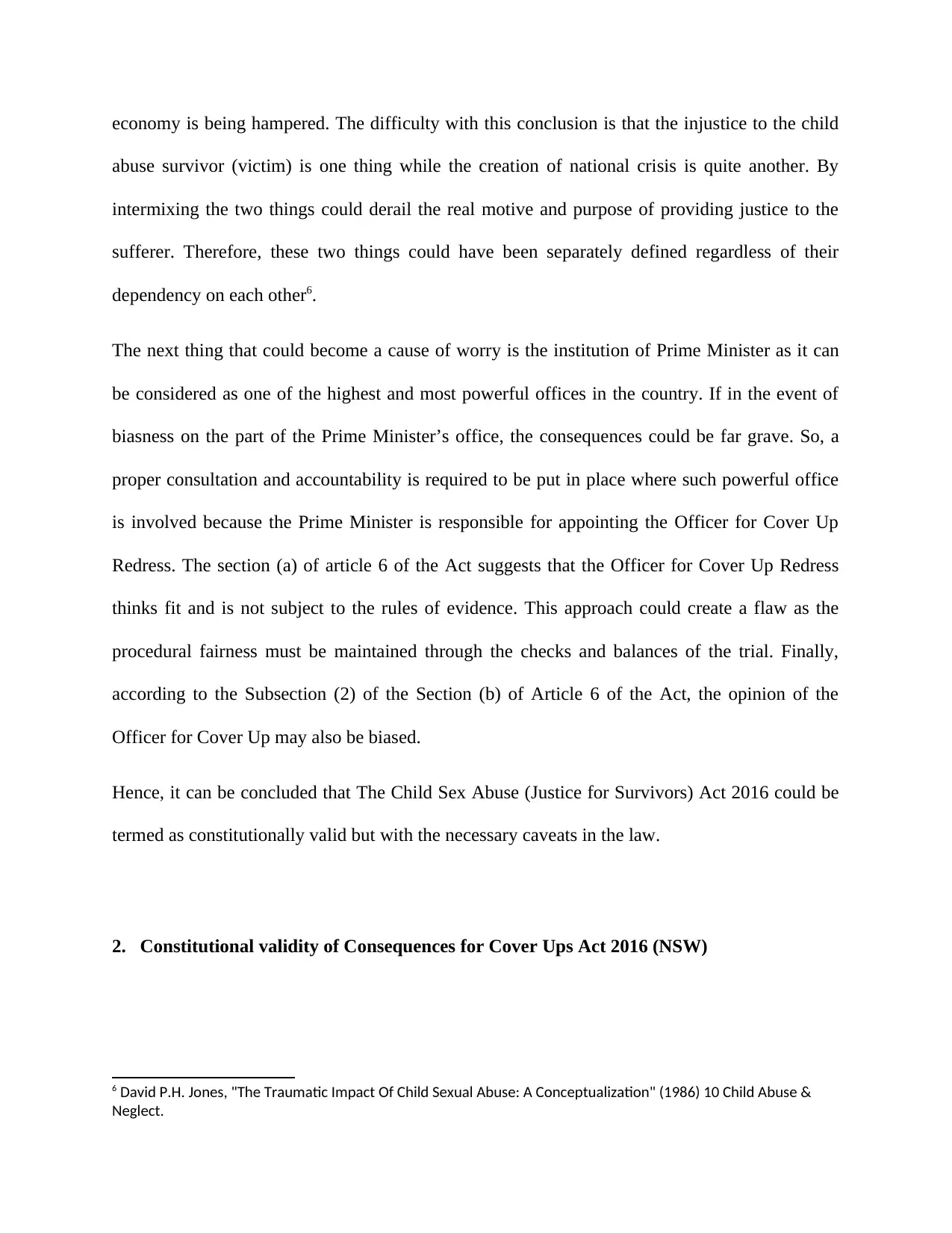
economy is being hampered. The difficulty with this conclusion is that the injustice to the child
abuse survivor (victim) is one thing while the creation of national crisis is quite another. By
intermixing the two things could derail the real motive and purpose of providing justice to the
sufferer. Therefore, these two things could have been separately defined regardless of their
dependency on each other6.
The next thing that could become a cause of worry is the institution of Prime Minister as it can
be considered as one of the highest and most powerful offices in the country. If in the event of
biasness on the part of the Prime Minister’s office, the consequences could be far grave. So, a
proper consultation and accountability is required to be put in place where such powerful office
is involved because the Prime Minister is responsible for appointing the Officer for Cover Up
Redress. The section (a) of article 6 of the Act suggests that the Officer for Cover Up Redress
thinks fit and is not subject to the rules of evidence. This approach could create a flaw as the
procedural fairness must be maintained through the checks and balances of the trial. Finally,
according to the Subsection (2) of the Section (b) of Article 6 of the Act, the opinion of the
Officer for Cover Up may also be biased.
Hence, it can be concluded that The Child Sex Abuse (Justice for Survivors) Act 2016 could be
termed as constitutionally valid but with the necessary caveats in the law.
2. Constitutional validity of Consequences for Cover Ups Act 2016 (NSW)
6 David P.H. Jones, "The Traumatic Impact Of Child Sexual Abuse: A Conceptualization" (1986) 10 Child Abuse &
Neglect.
abuse survivor (victim) is one thing while the creation of national crisis is quite another. By
intermixing the two things could derail the real motive and purpose of providing justice to the
sufferer. Therefore, these two things could have been separately defined regardless of their
dependency on each other6.
The next thing that could become a cause of worry is the institution of Prime Minister as it can
be considered as one of the highest and most powerful offices in the country. If in the event of
biasness on the part of the Prime Minister’s office, the consequences could be far grave. So, a
proper consultation and accountability is required to be put in place where such powerful office
is involved because the Prime Minister is responsible for appointing the Officer for Cover Up
Redress. The section (a) of article 6 of the Act suggests that the Officer for Cover Up Redress
thinks fit and is not subject to the rules of evidence. This approach could create a flaw as the
procedural fairness must be maintained through the checks and balances of the trial. Finally,
according to the Subsection (2) of the Section (b) of Article 6 of the Act, the opinion of the
Officer for Cover Up may also be biased.
Hence, it can be concluded that The Child Sex Abuse (Justice for Survivors) Act 2016 could be
termed as constitutionally valid but with the necessary caveats in the law.
2. Constitutional validity of Consequences for Cover Ups Act 2016 (NSW)
6 David P.H. Jones, "The Traumatic Impact Of Child Sexual Abuse: A Conceptualization" (1986) 10 Child Abuse &
Neglect.
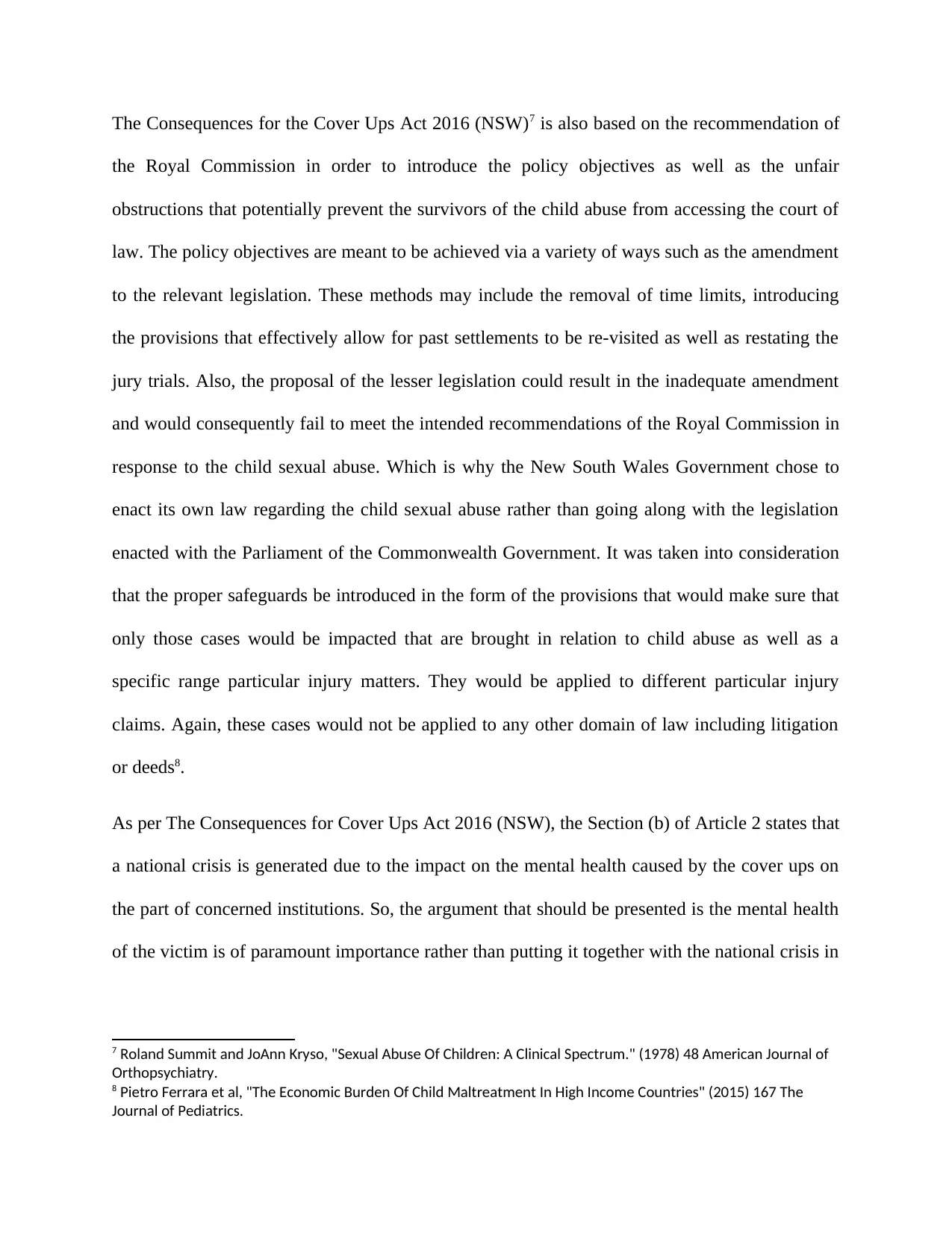
The Consequences for the Cover Ups Act 2016 (NSW)7 is also based on the recommendation of
the Royal Commission in order to introduce the policy objectives as well as the unfair
obstructions that potentially prevent the survivors of the child abuse from accessing the court of
law. The policy objectives are meant to be achieved via a variety of ways such as the amendment
to the relevant legislation. These methods may include the removal of time limits, introducing
the provisions that effectively allow for past settlements to be re-visited as well as restating the
jury trials. Also, the proposal of the lesser legislation could result in the inadequate amendment
and would consequently fail to meet the intended recommendations of the Royal Commission in
response to the child sexual abuse. Which is why the New South Wales Government chose to
enact its own law regarding the child sexual abuse rather than going along with the legislation
enacted with the Parliament of the Commonwealth Government. It was taken into consideration
that the proper safeguards be introduced in the form of the provisions that would make sure that
only those cases would be impacted that are brought in relation to child abuse as well as a
specific range particular injury matters. They would be applied to different particular injury
claims. Again, these cases would not be applied to any other domain of law including litigation
or deeds8.
As per The Consequences for Cover Ups Act 2016 (NSW), the Section (b) of Article 2 states that
a national crisis is generated due to the impact on the mental health caused by the cover ups on
the part of concerned institutions. So, the argument that should be presented is the mental health
of the victim is of paramount importance rather than putting it together with the national crisis in
7 Roland Summit and JoAnn Kryso, "Sexual Abuse Of Children: A Clinical Spectrum." (1978) 48 American Journal of
Orthopsychiatry.
8 Pietro Ferrara et al, "The Economic Burden Of Child Maltreatment In High Income Countries" (2015) 167 The
Journal of Pediatrics.
the Royal Commission in order to introduce the policy objectives as well as the unfair
obstructions that potentially prevent the survivors of the child abuse from accessing the court of
law. The policy objectives are meant to be achieved via a variety of ways such as the amendment
to the relevant legislation. These methods may include the removal of time limits, introducing
the provisions that effectively allow for past settlements to be re-visited as well as restating the
jury trials. Also, the proposal of the lesser legislation could result in the inadequate amendment
and would consequently fail to meet the intended recommendations of the Royal Commission in
response to the child sexual abuse. Which is why the New South Wales Government chose to
enact its own law regarding the child sexual abuse rather than going along with the legislation
enacted with the Parliament of the Commonwealth Government. It was taken into consideration
that the proper safeguards be introduced in the form of the provisions that would make sure that
only those cases would be impacted that are brought in relation to child abuse as well as a
specific range particular injury matters. They would be applied to different particular injury
claims. Again, these cases would not be applied to any other domain of law including litigation
or deeds8.
As per The Consequences for Cover Ups Act 2016 (NSW), the Section (b) of Article 2 states that
a national crisis is generated due to the impact on the mental health caused by the cover ups on
the part of concerned institutions. So, the argument that should be presented is the mental health
of the victim is of paramount importance rather than putting it together with the national crisis in
7 Roland Summit and JoAnn Kryso, "Sexual Abuse Of Children: A Clinical Spectrum." (1978) 48 American Journal of
Orthopsychiatry.
8 Pietro Ferrara et al, "The Economic Burden Of Child Maltreatment In High Income Countries" (2015) 167 The
Journal of Pediatrics.
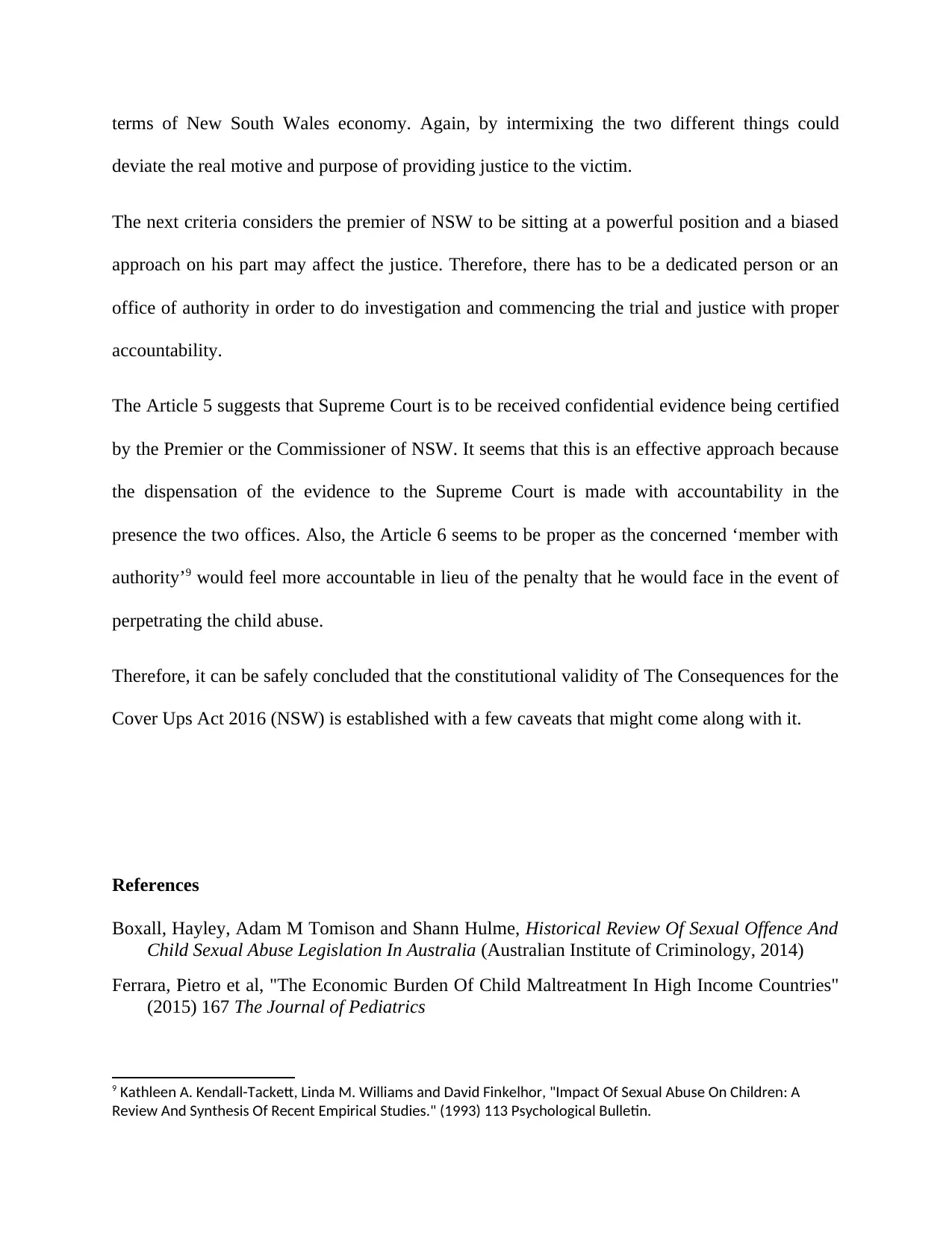
terms of New South Wales economy. Again, by intermixing the two different things could
deviate the real motive and purpose of providing justice to the victim.
The next criteria considers the premier of NSW to be sitting at a powerful position and a biased
approach on his part may affect the justice. Therefore, there has to be a dedicated person or an
office of authority in order to do investigation and commencing the trial and justice with proper
accountability.
The Article 5 suggests that Supreme Court is to be received confidential evidence being certified
by the Premier or the Commissioner of NSW. It seems that this is an effective approach because
the dispensation of the evidence to the Supreme Court is made with accountability in the
presence the two offices. Also, the Article 6 seems to be proper as the concerned ‘member with
authority’9 would feel more accountable in lieu of the penalty that he would face in the event of
perpetrating the child abuse.
Therefore, it can be safely concluded that the constitutional validity of The Consequences for the
Cover Ups Act 2016 (NSW) is established with a few caveats that might come along with it.
References
Boxall, Hayley, Adam M Tomison and Shann Hulme, Historical Review Of Sexual Offence And
Child Sexual Abuse Legislation In Australia (Australian Institute of Criminology, 2014)
Ferrara, Pietro et al, "The Economic Burden Of Child Maltreatment In High Income Countries"
(2015) 167 The Journal of Pediatrics
9 Kathleen A. Kendall-Tackett, Linda M. Williams and David Finkelhor, "Impact Of Sexual Abuse On Children: A
Review And Synthesis Of Recent Empirical Studies." (1993) 113 Psychological Bulletin.
deviate the real motive and purpose of providing justice to the victim.
The next criteria considers the premier of NSW to be sitting at a powerful position and a biased
approach on his part may affect the justice. Therefore, there has to be a dedicated person or an
office of authority in order to do investigation and commencing the trial and justice with proper
accountability.
The Article 5 suggests that Supreme Court is to be received confidential evidence being certified
by the Premier or the Commissioner of NSW. It seems that this is an effective approach because
the dispensation of the evidence to the Supreme Court is made with accountability in the
presence the two offices. Also, the Article 6 seems to be proper as the concerned ‘member with
authority’9 would feel more accountable in lieu of the penalty that he would face in the event of
perpetrating the child abuse.
Therefore, it can be safely concluded that the constitutional validity of The Consequences for the
Cover Ups Act 2016 (NSW) is established with a few caveats that might come along with it.
References
Boxall, Hayley, Adam M Tomison and Shann Hulme, Historical Review Of Sexual Offence And
Child Sexual Abuse Legislation In Australia (Australian Institute of Criminology, 2014)
Ferrara, Pietro et al, "The Economic Burden Of Child Maltreatment In High Income Countries"
(2015) 167 The Journal of Pediatrics
9 Kathleen A. Kendall-Tackett, Linda M. Williams and David Finkelhor, "Impact Of Sexual Abuse On Children: A
Review And Synthesis Of Recent Empirical Studies." (1993) 113 Psychological Bulletin.
Paraphrase This Document
Need a fresh take? Get an instant paraphrase of this document with our AI Paraphraser
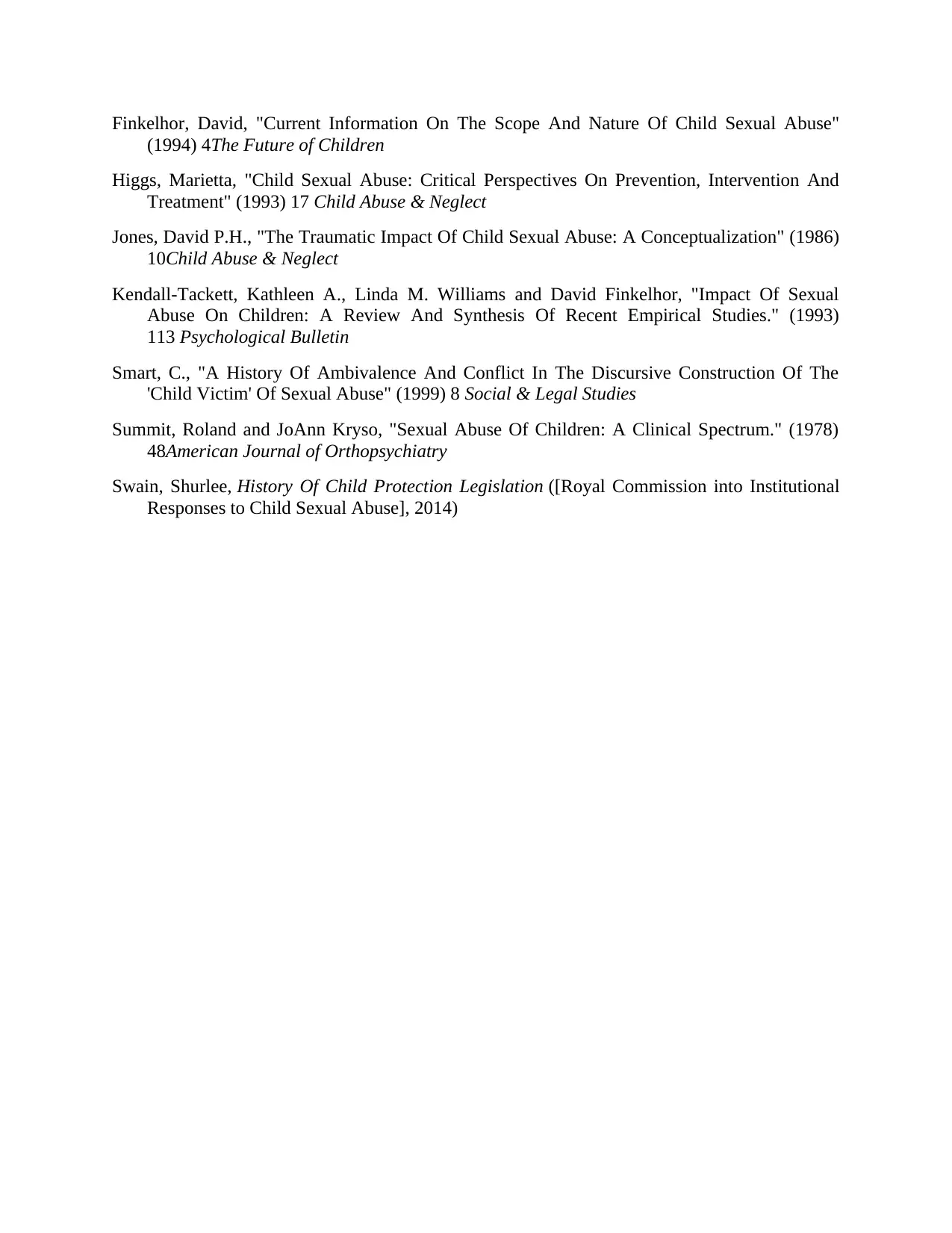
Finkelhor, David, "Current Information On The Scope And Nature Of Child Sexual Abuse"
(1994) 4The Future of Children
Higgs, Marietta, "Child Sexual Abuse: Critical Perspectives On Prevention, Intervention And
Treatment" (1993) 17 Child Abuse & Neglect
Jones, David P.H., "The Traumatic Impact Of Child Sexual Abuse: A Conceptualization" (1986)
10Child Abuse & Neglect
Kendall-Tackett, Kathleen A., Linda M. Williams and David Finkelhor, "Impact Of Sexual
Abuse On Children: A Review And Synthesis Of Recent Empirical Studies." (1993)
113 Psychological Bulletin
Smart, C., "A History Of Ambivalence And Conflict In The Discursive Construction Of The
'Child Victim' Of Sexual Abuse" (1999) 8 Social & Legal Studies
Summit, Roland and JoAnn Kryso, "Sexual Abuse Of Children: A Clinical Spectrum." (1978)
48American Journal of Orthopsychiatry
Swain, Shurlee, History Of Child Protection Legislation ([Royal Commission into Institutional
Responses to Child Sexual Abuse], 2014)
(1994) 4The Future of Children
Higgs, Marietta, "Child Sexual Abuse: Critical Perspectives On Prevention, Intervention And
Treatment" (1993) 17 Child Abuse & Neglect
Jones, David P.H., "The Traumatic Impact Of Child Sexual Abuse: A Conceptualization" (1986)
10Child Abuse & Neglect
Kendall-Tackett, Kathleen A., Linda M. Williams and David Finkelhor, "Impact Of Sexual
Abuse On Children: A Review And Synthesis Of Recent Empirical Studies." (1993)
113 Psychological Bulletin
Smart, C., "A History Of Ambivalence And Conflict In The Discursive Construction Of The
'Child Victim' Of Sexual Abuse" (1999) 8 Social & Legal Studies
Summit, Roland and JoAnn Kryso, "Sexual Abuse Of Children: A Clinical Spectrum." (1978)
48American Journal of Orthopsychiatry
Swain, Shurlee, History Of Child Protection Legislation ([Royal Commission into Institutional
Responses to Child Sexual Abuse], 2014)
1 out of 8
Related Documents
Your All-in-One AI-Powered Toolkit for Academic Success.
+13062052269
info@desklib.com
Available 24*7 on WhatsApp / Email
![[object Object]](/_next/static/media/star-bottom.7253800d.svg)
Unlock your academic potential
© 2024 | Zucol Services PVT LTD | All rights reserved.




